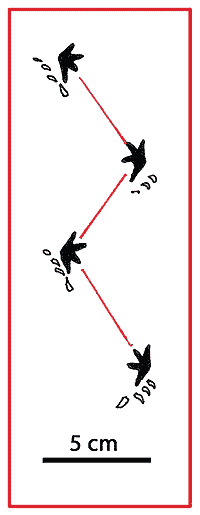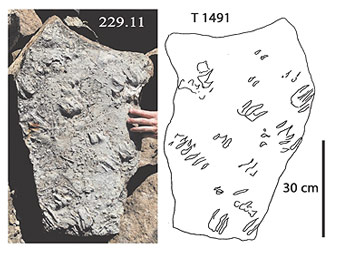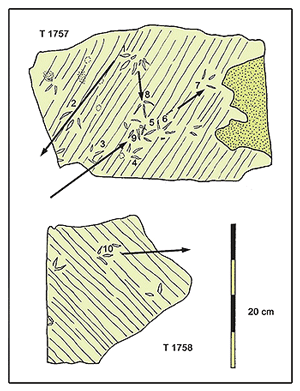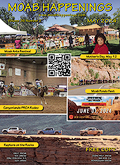 |
| Idealized frog trackways reveal distinctive four toed front footprints in walking configuration. Frog tracks were probably common in the Cretaceous but few have survived natural weathering processes. Despite recent discoveries in the Cretaceous of Korea, showing trackways of hopping frogs, only one Cretaceous frog track is known from all of North America. |
In Moab Happenings for September and October we reminded ourselves that the large tracks known from the Book Cliffs area between Western Colorado and Price, Utah have actually been known for a century. They have local appeal due to their large size and the fact that both miners and local geologists have been able to collect them and enjoy a sense of discovery. In previous generations they would sometimes have been described as natural curiosities. Collecting tracks from coal mines is also something of a dangerous pastime. Not just due to collapse of mine roofs but also due poisonous gasses. So local miners gained reputations for being inquisitive and finding unusual fossils.
Fascinating as well-preserved tracks are, it always helps to ask what stories they tell. What is the context in which they are found. Some of the largest tracks in the Book Cliffs area represent giant hadrosaurs or duck-billed dinosaurs. When first excavated some could be described as the world’s largest. Some large surfaces yield a diversity of information including evidence of rare species that are not easily preserved. For example, whereas tracks of duckbilled dinosaurs are common those of birds, pterosaurs and frogs are very much rarer. The fact that they are small makes them harder to find. Whereas there are thousands of tracks of large duckbills in the upper Cretaceous of North America only one set of frog tracks has been described small enough to fit under your thumbnail.
In the 1980s a large surface with many relatively large tracks (15-35inches) indicated dozens of animal mostly progressing to the south. These types of large surfaces provide context and suggest that the trackmakers were gregarious.
Another large track-bearing surface was reported from near Price in the 1980s. A map of the site showed the distribution of standing trees, and the spaces between stumps that allowed interpretation of dinosaur activity in this forested area. As we know from the local geology the track-rich sediments represent coal swamp environments with abundant plant remains and the following footprint types: duck-billed, horned ceratopsians, therapod (2 types), bird, pterosaur, turtle and crocodilian. This diversity of 8 track types is significant and shows a healthy ecosystem inhabited by a diverse fauna some of which is quite modern (turtles, crocodilians, birds) interspersed with extinct forms (large dinosaurs and pterosaurs). Imagine being transported back to the Late Cretaceous say 80 million years ago. Flowering plants had evolved and a stroll along the coastal pain would have reveled evidence, especially tracks, of birds, turtles and crocodiles. In this regard the sense of the fauna a was quite modern. Frog tracks as those of birds would have quite easy to find. It is only because they are small and easily eroded that they today appear rare. But this was a world in transition and the flocks of pterosaurs and herds of large duckbills, horned dinosaurs and large carnivorous theropods would have reminded us that we were still witnessing life at the end of the age of dinosaurs.
 |
 |
| Turtle swim tracks from the Book Cliffs in the Debeque Canyon area. |
Small bird tracks from the late Cretaceous Uinta Formation are only about and inch in length. |
|



